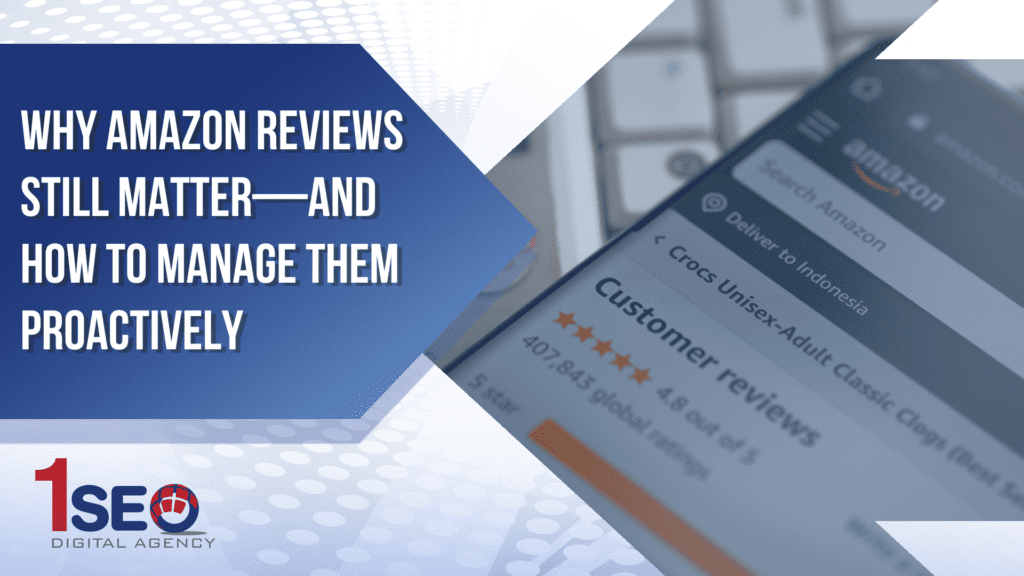Speak To An Expert Now: 215-946-1046
It’s HOT Outside – But EVEN HOTTER Online!
It’s the start of another glorious work week in July, and, just in case you haven’t been paying close attention, it’s a bit on the

For ecommerce brands looking to scale, reviews are not optional; they are a cornerstone of customer perception and purchasing decisions. Whether you’re an established seller or an emerging Amazon FBA startup, leveraging reviews to build brand awareness and consumer loyalty is critical.
Reviews operate as social proof, influencing the algorithm, shaping advertising performance, and anchoring your product’s visibility in the digital shelf. Every rating contributes to the customer experience by providing authentic insights into your offerings. Shoppers trust other customers more than they trust brand messaging, making Amazon customer reviews an unparalleled communication tool in the buying journey.

Despite evolving marketing strategies and the growing influence of social media, Amazon reviews remain central in ecommerce for one reason—Amazon itself is still the dominant force in online shopping. When consumers begin their product research, many skip Google search entirely and go straight to Amazon. This is where your reviews come into play.
The Amazon algorithm heavily favors products with higher review counts and better ratings. This impacts your presence on search engine results within Amazon, where most purchasing decisions happen. Amazon feedback directly influences product rankings, meaning your visibility—and sales—can live or die by the strength of your reviews.
Positive feedback acts as free advertising. It works in your favor 24/7, helping build brand credibility and supporting the perception that your product is the right choice. On the flip side, negative reviews can be devastating, especially when left unmanaged. Poorly handled negative feedback or an accumulation of low ratings can bury your listing and damage your brand reputation.
Too often, Amazon sellers wait until problems arise before taking action on review management. This reactive approach leaves you vulnerable to unpredictable shifts in customer satisfaction. Proactive review management involves setting up a system that consistently gathers feedback, monitors sentiment, and uses automation and artificial intelligence tools to optimize the customer experience before issues escalate.
Using seller tools like Jungle Scout and the Amazon Seller Central dashboard, you can implement review request campaigns that encourage satisfied customers to leave feedback. When strategically planned, review requests can significantly increase your volume of positive reviews, thereby improving your product rating and reputation.
More importantly, when customers see timely, thoughtful replies to reviews—especially negative ones—it sends a powerful message that your brand values transparency and takes customer service seriously. This kind of communication fosters long-term loyalty, elevates customer satisfaction, and helps you stand out in a saturated market.
DTC brands face a unique challenge on Amazon due to limited access to customer data, especially email addresses. Unlike selling through your own site, where building an email list is standard, Amazon restricts direct access to buyer contact info. However, that doesn’t mean you can’t request reviews effectively.
Tools and tactics such as Amazon’s “Request a Review” button in Seller Central, QR code inserts within packaging, and follow-up messages that comply with Amazon’s policies are all viable avenues. These elements form the basis of ethical review requests, helping boost positive reviews while maintaining policy compliance and avoiding black hat tactics.
Black hat strategies—like paying for fake reviews or incentivizing ratings outside Amazon’s guidelines—may deliver short-term benefits, but they carry serious long-term risks. Amazon’s review policy is strict, and violations can lead to penalties, including suspension from the Amazon Brand Registry or complete account termination.

Managing reviews should be part of a broader customer experience strategy. Every piece of feedback, whether glowing or critical, is a data stream waiting to be tapped for insights. By examining review content through digital shelf analytics, brands can identify common complaints, track product quality issues, and improve messaging clarity.
Consumer feedback also informs your inventory planning. If multiple reviews cite delays, damaged goods, or unclear product descriptions, it’s a clear signal that your fulfillment or product page needs improvement. With real-time monitoring and software tools that integrate analytics, you can turn reviews into actionable intelligence.
The emotional tone of reviews—the language used, the reasoning behind ratings, and the perception of value—offers a window into consumer behavior. With the rise of generative artificial intelligence, brands now have access to advanced text analysis capabilities that can process thousands of reviews and deliver meaningful patterns.
Amazon’s search algorithm is engineered to reward listings that are complete, accurate, and consistently well-reviewed. Reviews, both in quantity and quality, impact your organic rank and even influence the cost and placement of Amazon advertising.
This is why your review strategy should be central to your broader marketing strategy. Consider how keywords from reviews affect your visibility. When customers leave feedback that includes high-value search terms, your product is more likely to surface in relevant queries. Encouraging this kind of review content can be achieved through subtle prompts and post-purchase email communication, always ensuring compliance with Amazon’s rules.
Additionally, the review-to-rating ratio matters. A product with hundreds of ratings but few written reviews may not perform as well in Amazon’s search engine. Written reviews provide more indexable content and foster trust, making it essential to encourage not just star ratings but full-text responses.
Your review score is more than a number; it’s the visible expression of your brand’s reputation. It’s what convinces new customers to buy—or not. For DTC ecommerce brands seeking to build a long-term presence in the online marketplace, managing this reputation through thoughtful feedback response, consistent customer service, and regular data analysis is non-negotiable.
Positive reviews can be repurposed across marketing channels, from your website and product pages to social media and newsletters. By turning review content into promotional material, you extend the impact of satisfied customers’ words far beyond Amazon. This is especially effective in reinforcing brand loyalty and improving conversion rates through the power of word of mouth.
Tools that integrate Amazon feedback with broader CRM systems help DTC brands build cohesive customer profiles, despite Amazon’s data limitations. By syncing order history, review patterns, and post-sale messages, you can streamline your review management and enhance the end-to-end customer journey.
Negative reviews are inevitable, but they don’t have to be detrimental. The key lies in how you respond. Professional, empathetic replies that address the customer’s concerns demonstrate a commitment to service and transparency. They also provide valuable information to future shoppers who might be on the fence.
Replying to a negative review with a helpful message, offering a resolution or refund, and correcting misinformation where applicable can turn a dissatisfied customer into a loyal one. Even more, a well-crafted reply can boost your credibility in the eyes of potential buyers.
It’s important to remember that Amazon rarely removes reviews unless they violate specific policies. This means managing perception is crucial. Brands that succeed treat negative feedback not as a threat but as an opportunity to improve and demonstrate integrity.
As your brand scales, manually tracking every review becomes unmanageable. This is where automation tools and artificial intelligence step in. Software platforms now offer automated monitoring, sentiment analysis, and even pre-drafted responses based on review content. These tools not only save time but also ensure consistency in tone and accuracy in information.
Generative artificial intelligence is also being used to classify feedback, detect fraudulent reviews, and assist with multilingual communication. This is especially useful for brands participating in Amazon Global Selling, where reviews can span numerous languages and markets. By using AI to translate, analyze, and respond to reviews, you maintain a high level of customer service no matter the region.
A successful review strategy is not siloed. It connects with inventory management, pricing decisions, customer service, and marketing. For instance, products with frequent low-star reviews might warrant a change in supplier, an update in materials, or a price adjustment to match perceived value.
Likewise, trending topics in reviews can inform advertising strategy. If customers consistently mention how easy a product is to use, that insight can shape your next Amazon advertising campaign or product video. When reviews highlight quality or unique features, you gain new messaging angles to test in your digital marketing.
Review data also feeds into your brand registry performance. Amazon Brand Registry offers enhanced control over your listings, but maintaining strong review metrics ensures you fully benefit from the program’s advantages. High-performing listings with verified reviews are prioritized in the Amazon seller algorithm and are more likely to win the Buy Box.

In a fiercely competitive digital landscape, where perception equals profit and every rating impacts revenue, DTC ecommerce brands can’t afford to treat Amazon reviews as an afterthought. Success on the Amazon marketplace is rooted in more than just great products—it demands strategic oversight, data-driven communication, and an unshakable digital marketing foundation. That’s where 1SEO Digital Agency steps in.
As a trusted partner for growing ecommerce businesses, 1SEO offers tailored strategies that align with the needs of Amazon sellers. From intelligent automation to advanced analytics and cutting-edge marketing tactics, we provide the structure, support, and expertise to help your brand rise above the noise.
Our most relevant services for Amazon-focused ecommerce brands include:
With a full-service approach and a deep understanding of the Amazon ecosystem, 1SEO Digital Agency helps ecommerce brands protect their reputation, increase their positive feedback, and turn every customer interaction into an opportunity for growth. If you’re ready to streamline your review management and scale your Amazon business the smart way, it’s time to partner with 1SEO. Let’s grow your brand, together.
It’s the start of another glorious work week in July, and, just in case you haven’t been paying close attention, it’s a bit on the
Before the contracts are signed or the design work commences, web development is a process that begins with one thing: a vision. When a potential